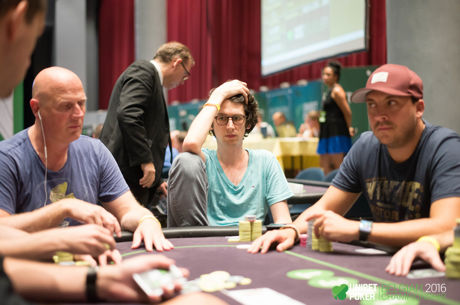10 Multi-Table Tournament Tips: Fast vs. Slow Structures

One of the great attractions of poker is the seemingly unlimited variety of ways to play the game. Besides the many different poker variants available, players can play for practically any stakes they wish — from matchsticks to millions — while also choosing from a number of different formats among both cash games and tournaments.
Over recent years tournament poker has emerged as a favored format for a lot of players, with the multi-table tournament (MTT) the choice of many. Even within the MTT scope there exist an array of different formats, including freezeouts (in which you can only enter once), reentry or rebuy tournaments (that allow you to buy back in if you bust), shootouts, short-handed and full-ring tournaments, large and small field tournaments, and of course a wide range of buy-ins, too.
When choosing a multi-table tournament, one of the most important factors players should consider is the "speed" of the tournament as dictated by the structure. Unlike cash games where the blinds never change, in MTTs the blinds increase with every level, with increasing antes being added as well. The relative speed of these blind/ante increases gives every tournament either a "fast" or "slow" structure (or something in between).
We're starting this series of multi-table tournament tips by focusing on fast versus slow MTT structures, including offering guidance for judging the speed of a tournament's structure as well as some strategic advice for how differently to approach fast tournaments versus slow ones. With these tips we'll primarily be talking about no-limit hold'em tournaments, although a lot of the strategy covered can apply to non-NLHE tournaments as well.
Fast vs. Slow Structures: Determining a Tournament's Speed
The speed of a multi-table tournament is determined by two factors:
- the depth of the chip stacks (in terms of big blinds)
- the length of levels
Going along with the length of the levels, some tournament structures additionally include larger than typical increases to the blinds and antes, which will also speed up the pace of a tournament.
One quick indicator of the speed of a given tournament is simply to look at the starting chip stacks and determine the number of big blinds each player has to start. For example, if the tournament gives everyone 1,000 in chips and the blinds for Level 1 are 25/50, each player starts with only 20 big blinds. In that case, you wouldn't even have to look further on the structure sheet to know — the tournament features a fast structure.
But say you begin with 10,000 chips with those same 25/50 blinds for Level 1. That's a starting stack of 200 big blinds — a "deep" stack that likely suggests a relatively slow structure, although you'll want to look ahead to make sure that is really the case.
Meanwhile the length of levels also importantly affects the speed of a tournament. It's not uncommon to encounter low buy-in tournaments featuring super quick levels — e.g., a $40 or $60 "daily" tournament in a casino with 15- or 20-minute levels. You might start with a "deep" stack of 100 big blinds or more, but with levels that short the average stack may be down to that 20-BB range within an hour, and suddenly the tournament is essentially a "fast" one.
By contrast, many higher buy-in tournaments feature longer levels of an hour or even more, with relatively small increases in blinds and antes also helping create a slow structure.
When playing online poker, hands are dealt more quickly than in live games, which means more hands get dealt per level. It varies, but in most cases you see almost twice as many hands online during the same time you play in a live tournament. That means a "fast" online tournament will be one with levels of 10 minutes or less, while an online MTT with levels lasting 20 minutes (or more) is a "slow" one.
Many sites helpfully designate faster MTTs as "turbo" (or "hyper-turbo") in the name of the tournament. Some also give you an idea in the lobby what the speed of a tournament is, such as on PokerStars where there is a column letting you know if a tournament's structure is "slow," "turbo," or "hyper."

Here's a quick rule of thumb for recognizing whether a MTT is "fast" or "slow":
Fast
- starting stack of 25 big blinds or fewer, and/or...
- for live tournaments, levels of less than half an hour (e.g., 15 or 20 minutes)
- for online tournaments, levels of less than 15 minutes (e.g., 10 minutes or less)
Slow
- starting stack of 50 big blinds or more, and/or...
- for live tournaments, levels lasting 45-60 minutes or more
- for online tournaments, levels lasting 20-30 minutes or more
You can call tournaments falling in between these two types "medium" speed if you like, although in truth it is probably better to think of most of them as starting "slow" for the initial levels, then at some point (usually) becoming "fast" once the average stacks dip down below 25 BBs.
Fast vs. Slow Structures: Strategic Differences
Put most simply, in fast-paced MTTs you need to play faster yourself — meaning you need to be prepared to play a more aggressive game (often from the very first level), to be prepared to commit chips earlier, and to be ready to put your opponents to a test for their stacks from the get-go.

Slower-paced tournaments reward patient players who are able to avoid marginal spots and wait things out while others make mistakes. Meanwhile playing too patiently (or too "tight") in a fast-paced tournament greatly reduces your chance of success, since folding your way through a few early levels can suddenly place you in "push-or-fold" mode where your chances of success are almost entirely tied to the strength of hands you're dealt.
The relatively shallow stacks of a fast-structured multi-table tournament also tend to make it more difficult for players to engage in postflop manuevering. That's not to say all decisions come before the flop in fast MTTs, but a lot of them will — particularly once the tournament has reached the third or fourth level and the antes have kicked in.
In fact, it isn't that unusual in an especially-fast MTT for a player to go most of the tournament making only preflop decisions and decisions on the flop, but not necessarily getting into turn and river play since by then the shorter-stacked player's chips will already be committed. That means in fast MTTs you'll often be thinking a lot about committing with hands every time you enter a pot — or at least you should be aware of that possibility.
On the other hand, if the structure is slow you definitely should be less eager to play for stacks early in a tournament. In other words, you have to "slow" your own play with relatively less aggression, not bloating pots and trying to exercise pot control (especially when holding marginal hands), and being generally a lot more selective about getting involved at all.
There's much more to say about how fast and slow tournaments each require a distinct poker strategy -- as well as the differences between "short-stacked" and "deep-stacked" poker. Suffice it to say it is crucial that you makes yourself aware of a tournament's structure and the relative urgency caused by those increasing blinds and antes, and adjust your play accordingly.
Fast vs. Slow Structures: Playing Styles and Experience
It is common to describe slower multi-table tournaments that feature more "play" as being advantageous to experienced players, while the fast MTTs tend to lessen the skill edge somewhat by introducing more "gamble" earlier on, thereby helping the lesser-skilled players have a better chance.
There's something to this observation. Since the slower-structured tournaments tend to involve more decisions per hand, players who are more seasoned — and therefore likely better at making such decisions — are going to benefit. With good reason, fast MTTs are often the preference of novice and/or recreational players, both because they often require less of a time commitment and because they afford players with less skill or experience greater opportunities to go deep and even to win.
That said, even experienced players sometimes will prefer fast MTTs because of the way they better suit their personal playing styles, especially if they are aggressive and prefer to be in action more frequently (and aren't as interested in practicing patience and folding a lot). On the flip side, sometimes players of moderate ability might rather play slower-structured, "deep-stacked" MTTs because they prefer playing a tight, patient game in which they can be selective about getting involved.
Even so, both fast and slow tournaments require — and reward — skillful play.
Conclusion
In a practical sense, you could argue that every multi-table tournament is both "fast" and "slow." It all depends on the perspective of the player making the observation.
For the short-stacked player down to just 10 big blinds, it doesn't matter what the overall structure of the tournament is — for that player it has become a fast one. And for the chip leader sitting comfortably behind a mountain of 100-plus big blinds, things have slowed down in a relative sense.
Being able to adjust and play correctly — whatever the tournament's speed — is essential.
Also in this series...
- The Importance of Stack Sizes
- Chip Accumulation vs. Survival
- How to Play the Early Levels
- Middle Stage Strategy
- Approaching the Bubble
- Strategy on the Bubble
- In the Money
- Going for the Win
- Bankroll Management for Poker MTTs
Ready to take a seat at the table? Put these multi-table tournament tips into practice at PokerStars.
In this Series
- 1 10 Multi-Table Tournament Tips: Fast vs. Slow Structures
- 2 10 Multi-Table Tournament Tips: The Importance of Stack Sizes
- 3 10 Multi-Table Tournament Tips: Chip Accumulation vs. Survival
- 4 10 Multi-Table Tournament Tips: How to Play the Early Levels
- 5 10 Multi-Table Tournament Tips: Middle Stage Strategy
- 6 10 Multi-Table Tournament Tips: Approaching the Bubble
- 7 10 Multi-Table Tournament Tips: Strategy on the Bubble
- 8 10 Multi-Table Tournament Tips: In the Money
- 9 10 Multi-Table Tournament Tips: Going for the Win
- 10 10 Multi-Table Tournament Tips: Bankroll Management









